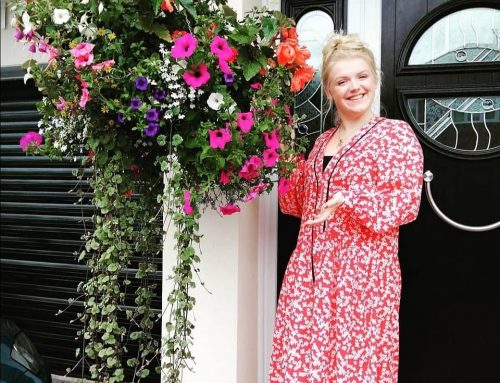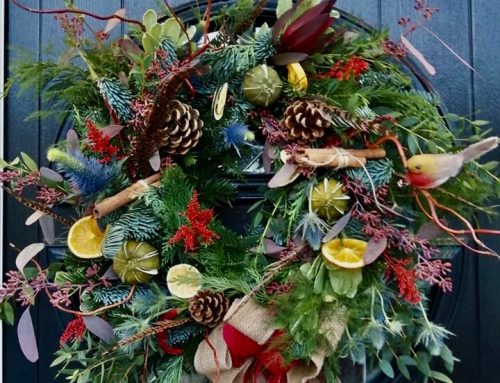Growing Edible Flowers in Stockton-on-Tees, County Durham and Teesside
At Green Onion Landscaping in Stockton-on-Tees, we love helping people create gardens that are both beautiful and practical. From wildlife-friendly planting to edible flowers and herbs, our work across County Durham, Teesside and the North East often draws inspiration from the natural world. My own fascination with growing edible flowers, berries and leaves began many years ago, shaped by a family tradition of foraging and growing food together.
Where Did It All Begin
My fascination with growing edible flowers, berries and leaves definitely stems (pardon the pun) from having parents who were foragers. They loved both growing and searching for edible flowers and berries to make their own food and drinks.
Violets, dandelion heads, elderflowers, violas and roses were often used in dishes or drinks my mum and dad made. I have very fond memories of sitting in our garden in the blazing sun in the 1970s, tasting marigold petals and leaves for the first time. I still remember being amazed by that clean citrus flavour.
Marigolds are perfect for adding to salads, sandwiches, seafood dishes or even hot desserts. They both look and taste wonderful.
My Father and His Foraging Inspiration
A creative genius who could turn his hand to almost anything, my dad was also an amateur winemaker. His home brew could probably knock out anyone brave enough to have a glass or two.
He often roped me into collecting rose hips, elderflowers, elderberries or dandelion heads for his experimental winemaking. I enjoyed it, and he and his friends certainly enjoyed his very alcoholic homemade rose petal or elderberry wine, as well as his dandelion and burdock.
It was this early experience of working with natural, homegrown ingredients that first sparked my love for growing edible flowers, a passion that still runs through everything we do here in Stockton-on-Tees today.
Childhood Memories of Foraging in Teesside
In the 1970s, when I was a kid, I often got odd looks or even a telling off from my friends’ parents when they caught me tucking into their window boxes or nibbling on their bedding plants. I would try to explain that they were edible and delicious, but I usually just got strange looks in return.
They would warn their own children not to copy my behaviour. To be honest, I was probably more at risk from any pesticides they had used than from the edible flowers themselves.
Family Foraging in County Durham and the North East
My parents regularly took me and my siblings on foraging trips across County Durham, Teesside and the North East. These trips were never planned, they just happened whenever someone spotted something that could be used for wine, salads, soups, chutneys or jams.
My brother, sister and I quickly learned which flowers, leaves and berries were safe to eat. Those carefree days felt like little adventures. We always turned our finds into something fantastic to eat or drink at the end of the day. It was bliss.
Grow Your Own Edible Flowers and Berries
I always recommend growing your own selection of edible flowers, berries and leaves in your garden here in Teesside. This way, you can be sure they are clean, fresh and free from pesticides, pests or disease.
Edible plants are always best picked fresh from your garden on the day you plan to use them. Another huge advantage of growing your own is the joy of experimenting and showing off to dinner guests what you have both grown and created with your homegrown colourful and tasty flowers.
Here are some of my favourite edible flowers, leaves and berries, along with some delicious ideas for using them.
Nasturtium: Edible Flowers with a Cheeky Bite
Harvesting nasturtiums from my garden in Stockton-on-Tees is something I have enjoyed for many years. As a long-time wild food enthusiast, I have gathered edible plants from all sorts of unlikely spots, but there is nothing quite like growing and picking your own.
It makes me feel happy, proud and light as air. Nasturtiums have vibrant yellow and orange blossoms with rounded leaves. They are not just edible, they are incredibly tasty.
If you enjoy radish or watercress, you will love these. The petals start off sweet, then turn peppery hot, just like a radish. The leaves and flowers are milder than the stems, and if you fancy a kick and a quick sinus clear out, try nibbling a stem. It is unreal, gorgeous, just wow.
Then there are the seed pods, crunchy, hot and mustardy. They taste divine and are often called poor man’s capers. Personally, I think they are far more flavoursome. I like to pickle them.
Spice up your meals by adding nasturtium leaves to salads, sprinkling them into soups, mixing them with chives, or using chopped blossoms and leaves in omelettes, coleslaw or mixed salads.
Bee Balm for Colour and Flavour
Fresh bee balm leaves can be added to pesto, while the flower petals make a fragrant and beautiful garnish. They are lovely in salads, herbal butter, ice cream or cream cheese spreads.
Bee balm petals are also a wonderful way to add colour and a light floral note to a fresh fruit salad. If you are growing edible flowers in your County Durham or Teesside garden, bee balm is a great choice.
Wild Garlic and Nettle Soup from the North East
Spotting wild garlic and nettles is a sure sign that spring is on its way across County Durham and Teesside. Do not be put off by the word garlic, both ingredients are mild in flavour.
Cooked wild garlic tastes more like spring onions, while nettles have a fresh hay-like flavour. Sauté them with butter, then blend with potato and leek to make a mild earthy soup that tastes fantastic. Try it, you will not regret it.
Recipe for Wild Garlic, Nettle, Leek and Potato Soup
Ingredients
5 medium leeks
1 bunch green garlic
5 tablespoons unsalted butter
1 medium shallot, diced
1 large russet potato, peeled and diced
6 cups chicken stock, plus extra if needed
Salt and freshly ground pepper
3 bags of nettles (as you would find at Tesco, Aldi or Lidl)
Garnishes
Hard-boiled egg
Bacon
Olive oil
Mustard flowers
Oxalis flowers
Dried nettle chips
Crème fraîche
Chives
Preparation
Trim the dark green leaves and roots from the leeks and garlic, slice them lengthwise and rinse well. Chop into quarter inch slices.
Melt the butter in a large pan. Add the leeks, green garlic and shallots, cooking slowly without browning until soft and translucent. Add the potatoes and cook for another two minutes. Pour in the chicken stock and season to taste.
Simmer gently for about twenty minutes until the potatoes are tender. Meanwhile, blanch the nettles for ten seconds in boiling salted water to remove the sting, always use tongs. Transfer immediately to ice water to stop the cooking and preserve their bright green colour.
Squeeze out the excess water, then purée the nettles with the soup. Garnish with your choice of edible flowers and serve hot or cold.
Summer Holidays and Simple Foraging Joy
During the summer holidays, it was not unusual to find me and my siblings picking edible flowers, berries or fruit in local parks, woodlands, fields or our garden around Stockton-on-Tees.
We probably saved our parents a small fortune on lunches, snacking our way through edible wildflowers, berries and fruit we found in fields, woodlands or even neighbouring gardens when we were out with friends.
Memories of Great Uncle Cyril Hay
One of my fondest memories is picking a huge hoard of mulberries from our local park with our Great Uncle Cyril. He was used to our foraging habits and never discouraged us. To be honest, he did not have much choice, he was not a strict man, more soft-hearted than anything.
We were brilliant at spotting fruit from a distance, and before he could blink, we would be up the tree like a bunch of monkeys. That day was pure joy. I felt like I had discovered treasure. I knew Mum and Dad would be thrilled, and sure enough, we turned our haul into all sorts of treats.
We filled anything we could find with mulberries, including our mouths. Back at Uncle Cyril’s, he let us make milkshakes and a pie, and we took the rest home for Mum and Dad. Mum made jam and Dad used his share for homemade wine.
Those memories are so precious to me, and they are the reason I still get such a buzz from foraging for beautiful edible flowers, berries and leaves here in Stockton-on-Tees, County Durham and across Teesside today.




